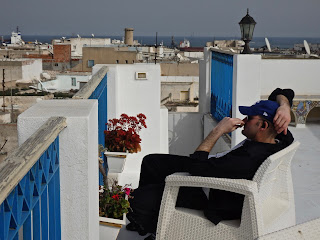A coworker told me on Monday that it was "very brave" of us to go to Tunisia. I assume he was referring to the 2015 terrorist attacks in Tunis and Sousse.
I think Sousse gets a bad rap. Paris was also the site of a terrible terrorist attack, and so were Nice, London, Berlin, and of course New York. People still visit all of those places. In fact, no one thinks twice about whether to go to the Eiffel Tower or the Brooklyn Bridge. But in Sousse, tourists are staying away. And in Sousse in the winter, there's hardly a camera-toting, zip-off pants wearing foreigner to be found.
We spent four nights in the ancient seaside city of Sousse. If the Phoenecians had an all-inclusive hotel, it would have been here. Like a lot of what we saw in Tunisia, Sousse is a hodge-podge, a mutt, built by layer upon layer of civilization. Like much of Tunisia, Sousse does not amaze you with its beauty. But it makes you want to peel back another layer of history and look underneath. It made me want to peek behind every blind corner and brightly painted door, to walk extra slowly past the cafes full of men whiling away their time smoking cigarettes and playing cards.
In Sousse, we stayed at a pretty guest house nestled into a quiet corner of the Medina. The loudest noise, in fact was the call to prayer in stereo sound from at least 3 different mosques in the neighborhood, starting at 5:30am. And then there was the rooster. Just around the corner was was the souk, with vendors offering spices, raw fish, knock-off Adidas clothes, leather slippers... all for a special price, just for you, my friend.
 |
| Atop our hotel |
 |
| Our hotel from 1775 - oldest house I have every slept in |
 |
| The Kasbah in Sousse |
From the old town you can walk directly to the shipping port. A quick left took us to the busiest intersection in town and a statue of Habib Bourghiba, Tunisia's first president after independence from France. He was our landmark and stood atop his horse outside the bustling Place des Martyrs where a WWII Allied bomb blew up part of the 8th century city wall.
A quick walk north takes you to Sousse's beachfront corniche, whose newest and most stable structure is its well-swept sidewalk. It's easy to imagine this as a chic seaside destination, but the 2015 terrorist attack dealt a deadly blow to tourism here and many of the hotels have peeling paint and crumbling patios. I got the feeling it was quite a hot spot in 1989. The hotel strip is cool in an almost ghost town kind of a way. Only some locals strolled down the corniche and a few hardy swimmers splashed into the cool blue sea.
A few blocks inland are Sousse's residential neighborhoods, with some high-rise buildings and worn apartment houses above cell phone stores and beauty salons. They might have an orange tree or two out front, a stray cat eating out of the garbage, bright rugs airing on the balcony and a roof-top satellite dish to cap it all off.
I would do Sousse an injustice not to mention Planet Food. It is a copy of the American Planet Hollywood restaurants of the 90s - in decor at least - and the unfortunate site of the worst restaurant meal I can remember eating. Catherine, Brian and I sat under photos of Clint Eastwood and Denzel Washington, eating mushy vegetables and rubbery meat. It was so bad we couldn't stop laughing. We kept laughing about it the rest of the week.
Was Planet Food more appetizing when those beachfront hotels were full? Does Habib Bourghiba look down with pride at Tunisia's second city of Sousse? Are those $6 sunglasses for sale on the street really Ray Bans? Those might be questions for the ages, secrets kept cool in a shadowy corner of the medina.
Is Sousse worthy of a few hundred busloads of pale tourists to keep it going this summer? I say it certainly is. I'd like to think that this era is just one thin layer in the long history of Sousse and of Tunisia.







No comments:
Post a Comment